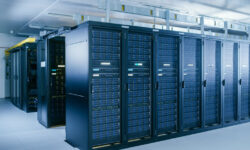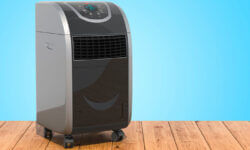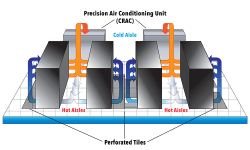Anyone who owns a commercial building knows that ductwork is an integral part of the property’s operations. In order to operate at maximum efficiency, your HVAC ductwork needs to be designed, sized, and installed correctly. Proper duct size is all too often an overlooked feature of commercial HVAC systems. The role that duct sizing and material play in maintaining a safe, comfortable environment should not be underestimated. Having the right size and material for your ducts will maintain comfortable conditions, improve indoor air quality, minimize energy losses, and lower your heating and cooling bills, as well.
Read more →Data centers represent some of the largest individual electricity users globally, accounting for roughly 3% of all consumption. That number continues to grow year over year. As such, every data center has a responsibility to be as efficient as possible. Much of that efficiency is going to come down to effective data center HVAC design.
Read more →Data centers power the internet; they house the number of servers where the internet’s websites and information are stored. These structures help ensure the internet runs, and HVAC systems are crucial to keeping the data centers running. HVAC systems serve an essential function in data centers: they control the air, temperature, and humidity to run the computer servers that power the internet.
Read more →Businesses have different needs when it comes to heating, ventilating, and air conditioning buildings and facilities. What every business has in common, though, is the desire to save money. Commercial enterprises analyzing their HVAC requirements can consider using portable spot air conditioners. Read on to know about these compact air conditioning units and if they’re right for your business.
Read more →‘Tis the season for fall and winter maintenance checklists galore. However, not all buildings are created equal, so should all HVAC maintenance lists be? Not really. While there are some commonalities across most commercial buildings, they can vary. So, that begs the question, what is the best HVAC maintenance list for your building? We have talked about typical fall maintenance but now, let’s break it down by building type and what could change.
Read more →Costs for data center outages rise minute by minute. And, each minute of unplanned downtime can cost upwards of $9,000. However, you can minimize unscheduled downtime and avoid preventable breakdowns with preventative data maintenance. The objective of preventative maintenance is to establish scheduled inspections that identify defects before they become a significant problem. Data centers that don’t schedule planned preventative data maintenance are at a higher risk of asset failure. Read on for some of the best tools for safe and successful preventative data maintenance.
Read more →Managing the temperature through compressors or ACs is a very expensive process. Cooling makes up at least 40 percent of your monthly energy consumption, which can quickly eat up your budget. Without HVAC, however, data centers would feel like the Sahara at the height of summer. This is why IT managers are trying to find ways to decrease temperature levels without racking up the electricity costs.
Read more →Figuring out the proper temperature for a data center can be a daunting task. Data centers are heavily relied on to keep confidential information safe and secure at all times. Here are some of the problems data centers face when temperatures rise too high, and what you can do to reduce them.
Read more →Proper temperature control for Data Centers during the winter is just as crucial as the summer. Cold weather causes its own types of problems for your data center. You have the ability to control and maintain both humidity and temperature; which helps alleviate the problems for data centers in winter.
Read more →Looking for ways to keep your Data Center Server Room cool? Consider the hot aisle/cold aisle layout is a design for server racks. This configuration is beneficial as it will conserve energy and lower cooling costs by directly managing air flow.
Read more →









